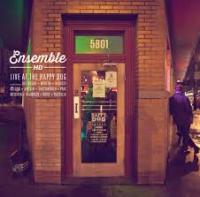Ensemble HD "Live at the Happy Dog"
Let's get two things straight up front here: the performers are not third stringers. Rather, all but one are members of The Cleveland Orchestra, the "big five" outfit that performs at Severance Hall and was once conducted by George Szell. And the recording engineer isn't someone's brother-in-law named Frank who just bought a copy of Pro-Tools and a pair of Radio Shack microphones he was anxious to break-in. He's famed Telarc engineer and Grammy Award winner Thomas Knab. Okay?
So what is this all about? It began with a conversation between Joshua Smith, the orchestra' principal flutist (or flautist if you prefer) and the Happy Dog's unlikely owner Sean Watterson, a hometown boy who made good (in international finance) and decided to buy the old bar that along with offering fifty toppings for its hot dogs, booked polka and indie-rock bands.
Smith suggested Watterson consider booking into the hot pink lit bar some classical music and as unlikely as it might seem, he agreed!
That was June of 2010. Instead of tuxes, the ensemble wore t-shirts and jeans. They set up near the bar and began to play. While the crowd near the ensemble was into it, those sitting further back predictably behaved as bar flies do, talking, being rowdy and not paying attention to the program of Mozart, Beethoven and Britten.
The group decided a piano was needed and brought in Christian Dahl, director of chamber music at SUNY, New York. That and a carefully chosen repertoire resulted in SRO crowds and the kind of quiet you don't get in concert halls because this audience is younger and less prone to nose-blowing, throat-clearing and sneezing.
So the ensemble of flutist Smith, Joanna Patterson Zakany on viola, Frank Rosenwein on oboe (he's the Cleveland Orchestra's principle oboist), violinist Amy Lee (she's the orchestra's associate concertmaster), cellist Charles Bernard (the orchestra's assistant principal cellist) and pianist Dahl decided to try to record live in a bar. It's difficult enough to record live in a concert hall. They were going for bar!
The program they chose was diverse and eclectic; including early Beethoven, Astor PIazolla's "Le Grande Tango", Anton Webern's "Satz für Streichtrio, op. Post", Benjamin Britten's "Phantasy, Op.2" some Ravel, Debussy (of course "Prelude to the Afternoon of a Faun"), some Shostakovich, Massiaen and Arvo Pärt too.
To finance the project, which they decided should be released on vinyl and be well-packed, they commenced a Kickstarter campaign last December and raised the $15,000 in thirty two days. That would cover half of the cost of the project. The producers chose to obtain the rest through other fundraising efforts and of course sales of the album.
Make no mistake: this is not classical music revised for the short of attention span. It has not been simplified, nor have the powerful emotions and serious subject matter of some of the pieces been trivialized. The heavy stuff is heavy while the impressionism like the Debussy, attains the lightness of being you might not think possible to produce in a bar.
I assumed the recording was digital given the expense and difficulty or recording analog remote, or even in a studio. However, the liner notes read "enhanced by the album's analog recording format…" Still, I suspect that is a reference to the storage medium but I could be wrong, especially because this is a gorgeous, sweet-sounding, texturally and harmonically rich "analog-sounding" recording.
It sounds closely miked and requires you to set the volume "just so" to produce the live illusion, though the room sound is most apparent during the applause at the end of the pieces. The absence of background noise, coughing, talking and the like is remarkable as is the audience's rapt attention, particularly on some of the more difficult pieces (only a few, don't worry).
This is an all-Cleveland production, from the orchestra to the recording engineer (Telarc, now owned by the Concord Group began in Cleveland) to the pressing plant: Gotta Groove. The 180g pressing quality is very good. There was a tiny bit on non-fill at the beginning of one side and tiny bits of crackling on another. Otherwise both physically and sonically, the pressing quality is outstanding. The triple gatefold packaging with its Edward Hopper-like cover art is attractively presented.
Everything about this project exudes quality. So why did the producers choose vinyl? Flutist Smith, who is the official instigator of this entire unlikely wonder says "Classical music really sounds good on vinyl. The sound quality is more open then on CD."
Do you love that? Of course you do! Will you love listening to this intimately and beautifully recorded recital performed in a bar? Of course you will. A more wondrous and wonderful Christmas present you could not buy for yourself of give to someone else because everything about this record is nothing short of miraculous. At the conclusion of the album ending Pärt piece "Spiegel Im Spiegel" (Mirrors in the Mirror") you are sure to find yourself uplifted into another dimension.



